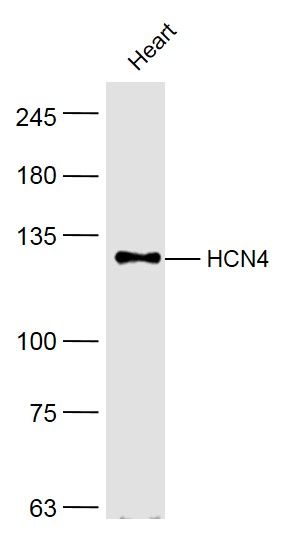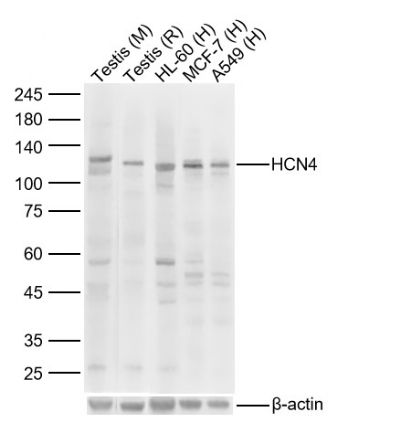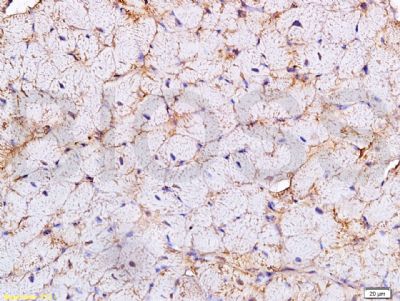HCN4 is a member of the family of hyperpolarization activated and cyclic nucleotide gated (HCN) channels. HCN currents have been linked to pacemaker activity in the heart and brain, resting potential control, as well as neuronal plasticity. It has been shown that HCN4 channels function as receptors for sour taste, and are associated with pacemaker potential generation in the sinoatrial node.
Function:
Hyperpolarization-activated ion channel with very slow activation and inactivation exhibiting weak selectivity for potassium over sodium ions. May contribute to the native pacemaker currents in heart (If) and in neurons (Ih). Activated by cAMP. May mediate responses to sour stimuli.
Subunit:
The potassium channel is probably composed of a homo- or heterotetrameric complex of pore-forming subunits.
Subcellular Location:
Membrane; Multi-pass membrane protein.
Tissue Specificity:
Highly expressed in thalamus, testis and in heart, both in ventricle and atrium. Detected at much lower levels in amygdala, substantia nigra, cerebellum and hippocampus.
DISEASE:
Defects in HCN4 are a cause of sick sinus syndrome type 2 (SSS2) [MIM:163800]; also known as atrial fibrillation with bradyarrhythmia or familial sinus bradycardia. The term 'sick sinus syndrome' encompasses a variety of conditions caused by sinus node dysfunction. The most common clinical manifestations are syncope, presyncope, dizziness, and fatigue. Electrocardiogram typically shows sinus bradycardia, sinus arrest, and/or sinoatrial block. Episodes of atrial tachycardias coexisting with sinus bradycardia ('tachycardia-bradycardia syndrome') are also common in this disorder. SSS occurs most often in the elderly associated with underlying heart disease or previous cardiac surgery, but can also occur in the fetus, infant, or child without heart disease or other contributing factors, in which case it is considered to be a congenital disorder.
Defects in HCN4 are the cause of Brugada syndrome type 8 (BRGDA8) [MIM:613123]. A tachyarrhythmia characterized by right bundle branch block and ST segment elevation on an electrocardiogram (ECG). It can cause the ventricles to beat so fast that the blood is prevented from circulating efficiently in the body. When this situation occurs (called ventricular fibrillation), the individual will faint and may die in a few minutes if the heart is not reset
Similarity:
Belongs to the potassium channel HCN family.
Contains 1 cyclic nucleotide-binding domain.
SWISS:
Q9Y3Q4
Gene ID:
10021
Database links:
Entrez Gene: 10021 Human
Entrez Gene: 330953 Mouse
Entrez Gene: 59266 Rat
Omim: 605206 Human
SwissProt: Q9Y3Q4 Human
SwissProt: O70507 Mouse
SwissProt: Q9JKA7 Rat
Unigene: 86941 Human
Unigene: 41082 Rat
HCN4阳离子通道结构蛋白,具有调节心脏起搏的功能蛋白。
| Picture |
Sample:
Heart (Mouse) Lysate at 40 ug
Primary: Anti-HCN4 (SL1691R) at 1/300 dilution
Secondary: IRDye800CW Goat Anti-Rabbit IgG at 1/20000 dilution
Predicted band size: 129 kD
Observed band size: 129 kD
Sample:
Lane 1: Mouse Testis Lysates
Lane 2: Rat Testis Lysates
Lane 3: Human HL-60 cell Lysates
Lane 4: Human MCF-7 cell Lysates
Lane 5: Human A549 cell Lysates
Primary: Anti-HCN4 (SL1691R) at 1/1000 dilution
Secondary: IRDye800CW Goat Anti-Rabbit IgG at 1/20000 dilution
Predicted band size: 129kDa
Observed band size: 129kDa
Tissue/cell: rat heart tissue; 4% Paraformaldehyde-fixed and paraffin-embedded;
Antigen retrieval: citrate buffer ( 0.01M, pH 6.0 ), Boiling bathing for 15min; Block endogenous peroxidase by 3% Hydrogen peroxide for 30min; Blocking buffer (normal goat serum,SLC0005) at 37℃ for 20 min;
Incubation: Anti-HCN4 Polyclonal Antibody, Unconjugated(SL1691R) 1:200, overnight at 4°C, followed by conjugation to the secondary antibody(SP-0023) and DAB(SLC0010) staining
|
|
|


